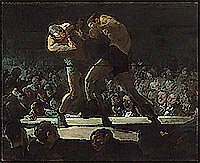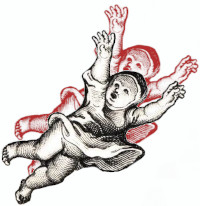Fighters at all levels tend to get hung up on their natural ability:
Strong men will feel like they are cursed to be forever slow.
Speedy fighter get hurt easy.
Hard hitters have to deal with everyone running from them.
Long fighters have trouble with timing and get frustrated against crafty fighters.
Smart fighters feel like they don't have the grit and ferocity that the natural fighters have.
All of these types and more hit their various low ceilings and either obsess on developing that aspect to an unproductive degree, possible resulting in injury or allow a defeatist mentality to develop. Sometimes fighters will get depressed about natural ability early, some at intermediate levels, some the first time they go elite, and some are forever plagued with self-doubt—which at least reflects a realistic ability to self asses. Do not discard your self-critique. Use it to establish or alter your trining path.
There is one thing that every fighter that strikes can do to make himself more effective, no matter if his tool is a sword, stick, hatchet, knife, razor or his bare hand and that is utilizing the visual field created by your body to hide your hand and weapon.
The opponent will see gross movement of the body before he sees a movement by the hand and/or tool contained within this visual field, his shadowed outline. That is why a stick fighter or machete man holds his weapon from hip to shoulder. This is why the jab is so effective, why the point of the sword became the duelist's article of faith and why thrusting with that point became the basis for modern boxing.
If you are momentarily frustrated with your sparring or competition performance, check your guard, check for breaks in your visual field and use the following guide for basic mechanics.
-Keep your hand or weapon within the outline of your body.
-Keep your elbow against your body until the last instant necessary.
-When thrusting or straight punching, while advancing or warding, or even giving ground—anytime you are moving in line with your opponent—move the hand first, the foot second.
-When moving lateral to your opponent—while doing a pass hook, a side-stepping jab, or doing a pass-slash with a weapon, move your feet first, then your hand, making sure to keep elbow continuity with the body and attempting not to make a big visual impression with the hand, glove or weapons, by keeping it before the line of your trailing shoulder and hip and driving through your visual field as you score.
-Constantly move, using micro-motions as much as possible. This is the reason why bare-knuckle boxers "milled" their fists, so the opponent would have a harder time telling when the strike was beginning.
You might not be as fast, but you can be first. More importantly, if he doesn't see it coming you don't need to be first or fast, or even hit hard, if his befuddled ass is walking
into it.
Please keep in mind that all the above are even more important in a survival situation. The last point will go from doing your fight dance to talking with your hands while you set him up or hitting on the walk.
And above all, while you are being hard on yourself, relax—that knucklehead in the mirror is going to require some patience.
The Punishing Art
Twerps, Goons and Meatshields: The Basics of Full Contact Stick-Fighting











Thank you. That's really great advice and the kind of stuff no one tells you. It makes perfect sense but I would have never thought of it.
If you got punched in the ear enough by a guy that led with sloppy left hooks, it would have eventually occurred to you.